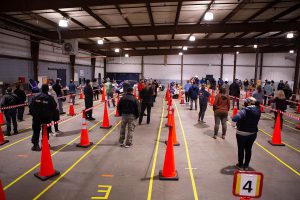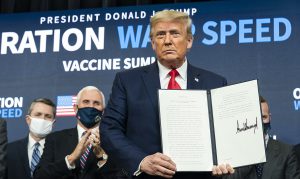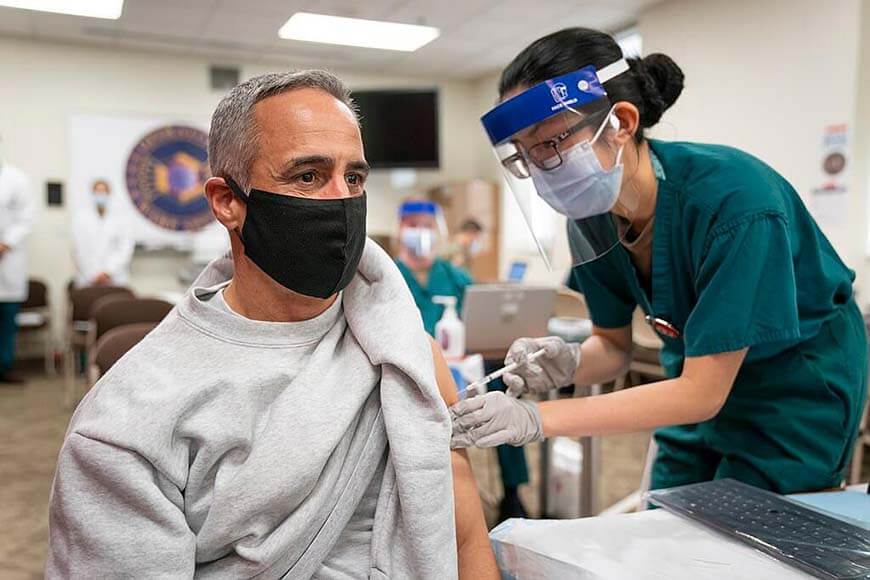Like more than 222,000 of her fellow Americans, a 75-year-old lung cancer survivor from New Jersey tested positive for COVID-19 on Monday.
It is believed that Bonnie Watson Coleman, a United States Representative, contracted it when sheltering with colleagues from a far-right mob that broke into, and sacked, the Capitol Building last week. Two other representatives have also tested positive, with others almost certain.
Like many of the rioters in the Capitol’s corridors, it is understood a number of conservative representatives did not wear masks or social distance. Dr. Robert Redfield, the head of the Centers for Disease Control and Prevention (CDC), has described the anti-democratic riot as a “significant [Covid-19] spreading event.”
Five lives were lost due to the violence at the Capitol on January 6. With 3,964 dying from COVID-19, it also marked the worst day of the coronavirus pandemic in the U.S. until that point. The following day, the death toll cleared 4000 for the first time.
More than 380,000 Americans have died of COVID-19. Over 22.6 million have now been infected.
Unlike President Donald Trump, who will leave office on January 20, the U.S. will continue dealing with the exhausting realities of the pandemic for longer, this year. Just how long will depend on the rollout of vaccines to the 328.2 million Americans. The early stages haven’t been hugely promising.
All the focus was on developing the vaccines. I don’t think there was enough focus on getting the vaccine into the arms of the people who need them.
“All the focus was on developing the vaccines,” Dr. Walter A. Orenstein, an epidemiologist at the Emory University School of Medicine and former director of the U.S. Immunization Program, told the Washington Post.
“I don’t think there was enough focus on getting the vaccine into the arms of the people who need them.”
With limited federal coordination and financial support, and a complex, but loosely mandated set of CDC guidelines on who should receive the vaccine first, the implementation of the rollout has been laid at the feet of states themselves.
As a result, responses have varied wildly, creating widespread confusion for high-risk groups who, in one case, saw young, non-essential hospital staff prioritized ahead of them. In another, elderly were forced to queue overnight to receive their first shot.
Indeed: with only 36 percent of all distributed doses administered so far, hundreds of thousands of vaccines sit unused across America while the pandemic’s latest, and worst, surge is negotiated by exhausted medical workers.
Hospitals and clinics have complained about the support needed to actually administer doses into arms, while supply and cold chain issues have added an extra squeak to an already bad wheel. A new administration and more soon-to-be approved vaccines entering the supply provide promise, but bad headlines for the first phase of the rollout are likely for the rest of the American winter.
Slow out of the blocks
Sandra Lindsay, a nurse from Queens, New York, received America’s first COVID-19 vaccination on December 14. In the coming days, Trump set a goal of 20 million Americans vaccinated by the end of December 2020.
According to Bloomberg and CDC data, as of yesterday, 9.94 million doses have been administered, with 636,172 people—fractionally more than America’s COVID-19 death toll—having received their second.
Since the Food and Drug Association’s (FDA) gave emergency approval to Pfizer and Moderna’s COVID-19 vaccines in December, the U.S. government has supplied more than 27 million doses to the states, who have the job of getting them into arms.
While this is not new—states organized their own vaccination programs during the 2009 swine flu outbreak—the pressure to do it now, with resources strained from nearly a year of fighting the pandemic, is that much harder.
A lack of federal funding and guidance hasn’t helped. After months of legislative inactivity, a second government stimulus package included up to $9 billion for vaccine distribution in December.
More than $20 billion for testing and contact tracing was also approved, but, along with widespread confusion around actual dose numbers states would get, critics say the delays meant states had little time to formulate ‘mix-ready’ vaccination plans.
“The prep work that had to be done was really immense,” Adrianne Casalotti, chief of government and public affairs at the National Association of County and City Health Officials, told Politico. “A lot of that has not been able to be accomplished because of not having the resources in advance.”
Differences between state rollouts have been stark. After a brutal November and December fighting COVID-19, North and South Dakota now, incredibly, rank first and second in the nation in vaccinating residents.
Around one in every 20 residents of the two Northern states has had the jab, with South Dakota yesterday announcing it was available to all those over 65. Only eight other states have administered vaccine doses at better than 50 percent. Texas has used 852,015, or 43.9 percent of its total doses.
Many states have lagged. While Georgia (21.5 percent), Alabama (23.1, and Hawaii (24.7) have the most vaccine cases sitting in storage, California (24.8) is the only other state that has used less than a quarter of its doses. The hugely populous West Coast state has seen its rollout humbled by widespread medical software issues.
An overly rigid following of the CDC’s prioritization guidelines has been blamed by several prominent public health officials, including Dr. Anthony Fauci, head of the National Institute of Allergy and Infectious Diseases, as slowing the rollout.
There was never a reason that states needed to complete vaccinating all health care providers before opening vaccinations to older Americans and other vulnerable populations.
The CDC split the initial vaccination prioritization phasing into several tiers, with healthcare workers, important public officials, and long-term care residents first in line, followed by the elderly and essential workers.
“There was never a reason that states needed to complete vaccinating all health care providers before opening vaccinations to older Americans and other vulnerable populations,” Alex Azar, the Secretary for Health and Human Services, told USA Today.
“States should not be waiting to complete [category] 1a priorities before proceeding to broader categories of eligibility.”
Amongst the states that have stuck to the “rigid guidelines,” New York has faced criticism after unused doses of the vaccine were thrown away. So far, the state has used 41.0 percent of its delivered doses. The speed of New York City’s rollout (35.8 percent doses used) is the same as Minnesota’s.
Last Friday, Governor Andrew Cuomo announced that New York would be expanding the vaccine eligibility groups to three million more residents, with those 75 and older now able to receive one.
Florida is offering vaccines to those over 65, but, having delegated logistics to individual counties, has already seen a slew of issues that have seen seniors waiting in line overnight for their first shot, confusing registration sites, and getting conned in outright scams.
With health care provider ranks exhausted by the ongoing COVID-19 crisis, the towering shortage of those able to administer vaccines may become more obvious as 2021 continues. Using the military, or calling up retired physicians and health care workers, have been suggested, though American armed forces will – at this stage – likely only provide logistical support.
Reticence, race, and the supply chain
Vaccine reticence by some healthcare workers—up to 29 percent, says one recent study—has helped create further bottlenecks. The Guardian reported that, incredibly, up to 40 percent of frontline medical workers in Los Angeles county were refusing a vaccination.
Some prominent medical establishments have taken things in the other direction. According to the New York Times, Nashville’s Vanderbilt University Medical Center inoculated 15,000 staff members, before starting on its own high-risk patients.

“Cronyism and connections have no place in the rollout of this vaccine,” Dr. Ruth Faden, a bioethicist at Johns Hopkins University in Baltimore, told the Times.
“If we don’t do this right, the consequences could be quite catastrophic, so it’s really critical that people be hypersensitive to the rules of the game here.”
Like every issue in American life, race is playing a prominent role in the initial stages of the vaccine rollout. A Pew Research poll in early December said that 83 percent of Asian-Americans plan to get the vaccine, compared to 63 percent of Hispanic Americans, 61 percent of white Americans, and just 42 percent of Black Americans.
Dr. Nikhila Juvvadi, the chief clinical officer at Chicago’s Loretto Hospital, told NPR that the Tuskegee syphilis experiment, one of the most shocking cases of unethical medical mistreatment in American history, had been mentioned to her by a number of patients.
“I’ve heard Tuskegee more than I can count in the past month – and, you know, it’s a valid, valid concern,” she said.
With COVID-19 taking Black and Latino American lives at twice the rate of white ones, states have pledged to ensure equal access to vaccines, with some going even further.
Colorado has acknowledged systemic racism within its vaccination plan, while the Wall Street Journal reports California “lists racial and ethnic minority groups among the “critical population” that could receive the vaccine ahead of other groups.”
Over the weekend, the CDC announced updated details on their suggested second (1b) and third (1c) vaccine phases, prioritizing the eldery, people with high-risk pre-existing conditions, and essential workers like grocery store workers and teachers.
The Journal wrote that some officials have said the recommendations could “benefit racial minorities without explicitly taking race into account,” given they were overrepresented in later two groups.
Cronyism and connections have no place in the rollout of this vaccine. If we don’t do this right, the consequences could be quite catastrophic, so it’s really critical that people be hypersensitive to the rules of the game here.
Despite North and South Dakota’s remarkable start to the rollout, cold chain storage issues will likely ensure rural America will have to do it harder, for longer, with COVID-19. Though the federal government agreed to supply pharmacies like CVS and Walgreens with the vaccine later this year, a recent study showed a third of all rural counties don’t even have a pharmacy.
Additional supply chain issues have seen shortages of dry ice, small glass vials, and the materials for vaccine doses also reported.
Turning on the afterburners
If you combine the immense scale of a national vaccination program in the U.S with the increasing politicization of basic public health measures, getting COVID-19 shots into American arms was always going to be a challenge.
Despite its issues, the U.S. is still administering vaccines at the fifth fastest rate in the world (averaging 3.03 doses per 100 people), following only Israel, United Arab Emirates, Bahrain and the United Kingdom.
America’s average dosage number has moved up noticeably over the last few days, while the amount of U.S. residents receiving their second dose virtually doubled in the last two days.
“We had this remarkable plan that Warp Speed had put in place to have doses ready to go the very next day after the FDA approval, but that’s a lot of logistics,” Dr. Francis S. Collins, head of the National Institutes of Health, told the Washington Post. “So maybe we shouldn’t be too shocked that it didn’t go like clockwork.”

There’s more good news on the way, too. Along with the Pfizer and Moderna vaccines, Johnson & Johnson is in the late stages of its clinical trials for a single-dose vaccine that could receive FDA approval in the next month.
If approved, Johnson & Johnson say they can deliver up to 100 million doses of the vaccine—which, importantly, would not require ultra-cold storage—around the states from February. Recent Times reportage says this might be unlikely.
Operation Warp Speed officials have hinted that the AstraZeneca/Oxford vaccine could receive approval as soon as March. Plans for mass vaccination efforts should be well under way by then, too.
Several states have announced plans for vaccination ‘mega-sites,’ with California to use Disneyland and two Major League baseball stadiums to potentially deliver tens of thousands of doses a day. Citi Field, home of the New York Mets, will perform the same function. Public schools are likely to be vaccine focal points, nationwide.
Despite Warp Speed’s success in incentivizing vaccine creation, the wider rollout will benefit from Trump leaving the White House next week. Strategic blunders have marked his administration’s response to the pandemic, while the president himself has delivered consistently inconsistent public health messaging about its severity.
“Every important COVID-19 metric – cases, deaths, and hospitalizations – is at or near its record high in the waning days of the Trump administration,” Dylan Scott, of Vox, wrote.
… right now, I think we just need to give a little bit [of] slack – not a lot, but enough to say, well, we’re past the holiday season, now let’s really turn the afterburners on.
Biden, who received his second vaccine dose on Monday, has promised a “hands-on” rollout approach that will include a quick stimulus bill that provides additional state vaccine funding, potential use of the Defense Production Act to make more doses, mobile units to administer the vaccine in “under-covered areas,” and a guarantee to give both doses of each vaccine to all Americans.
Amongst the vaccine gloom, there are enough signs that vaccine rollout be already be reaching for second gear, and moving out of first. Despite the political chaos at the Capitol last week, and the reality of the pandemic’s worst stretch so far, Dr. Fauci believes it’s time to take “turn the afterburners on.”
“If we don’t catch up on what the original goal was, then we really need to make some changes about what we’re doing,” Dr. Fauci told NPR, last week.
“But right now, I think we just need to give a little bit [of] slack – not a lot, but enough to say, well, we’re past the holiday season, now let’s really turn the afterburners on.”



